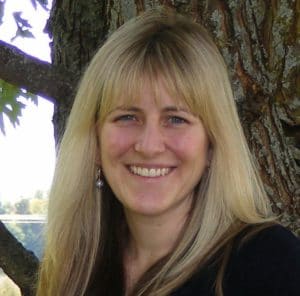
We are pleased to announce the winner of the 2019 Human Genetics SMRT Grant: Tychele Turner, an assistant professor who recently joined the Washington University in St. Louis School of Medicine.
Turner’s research focuses on neurodevelopmental disorders, particularly on finding answers to unsolved cases. Her project aims to sequence members of a family affected with autism, using long reads and the high accuracy of HiFi sequencing to try to identify a causal genetic variant. We spoke with her to learn more about this winning proposal.
Q: How did you get involved in studying neurodevelopmental disorders?
A: My interest in neurodevelopmental disorders goes back to my graduate school days. I worked in Aravinda Chakravarti’s lab, where I focused on studying autism, especially in families with multiple affected girls. In autism, there is a sex bias; about 80% of all cases are male. When you have a female with autism, that’s pretty rare, and when you have multiple affected females in a family, that’s even rarer. The prevailing thought is that it might just take a more severe mutation for a girl to become affected with autism. That’s where I started my research career.
Then I moved to Evan Eichler’s lab for my postdoc, where I did large-scale assessment of children with neurodevelopmental disorders — looking at thousands to tens of thousands of individuals using microarrays, whole-exome sequencing, and short-read whole-genome sequencing. We were able to find a lot of new genetic components, particularly from de novo mutations.
Q: Why is your lab focused on uncovering new genetic components associated with autism?
A: We can only explain about 30% of all cases today. It seems low because the heritability of autism is high, so we think there is more to discover. To find these things we haven’t been able to see before, I think part of the issue may be technology. That’s why I was really excited when the opportunity came for the PacBio grant. That’s just the kind of thing we might need to find the variation we can’t explore with the older technologies.
Q: How is the research community trying to get answers for the remaining 70% of cases?
A: One approach is adding more samples. As we sequence more and more people, we’re able to find more and more of those genes with statistical significance. I think the future is very bright on that front. But the other approach is using new technologies to find the types of variation that we’ve missed. We could implicate new genes and also go back to known genes and identify new mutations. I would call this completing the allelic series within the genes that reach significance. If we can get to that point, we can be very clear about all the contributing elements. It’s not fun to be limited by your technology.
Q: Why do you think HiFi sequencing could make a difference?
A: I think it’s really important because it will allow us to find structural variants — such as small deletions and duplications — that we never can see otherwise. I’ve worked a lot with whole genome sequencing from short-read data, but we’re limited with that technology. We can detect really big structural variants. If someone has a deletion that’s a megabase, we will see it. But if that person has a deletion that removes one exon of a gene, and that deletion is 200 base pairs, we have a really hard time finding that in our data. And if we do find it, we have a hard time pulling it out from the noise.
But with PacBio’s long reads, a 200 base pair deletion is no problem because you’ll see it within the actual read. You just map it to the genome, and you have your answer. That’s what I’m really excited about. It also lets you get into the GC-rich regions of the genome, which is important for repeat expansions like the one associated with fragile X syndrome.
Q: How do you foresee PacBio sequencing helping the family you are working with?
A: I’m working with John Constantino in the autism clinic here at WashU — he did a deep clinical workup on this family, which has two girls with autism who have a fairly severe phenotype. They have previously been tested with arrays and exome sequencing and so far, there have been no answers. We think the reason we haven’t been able to find a genetic event yet is probably a technology issue. Our plan is to do PacBio sequencing with the SMRT Grant and also to generate some data with complementary technologies. We’re going to go all in for this family.
Q: In your proposal, you described this approach as a “pathway for discovery.” What did you mean by that?
A: As a new lab, this is really exciting because we’re going to have the first opportunity to look at this kind of data and we think that it’s going to be important to use for other families in the future. In addition to getting an answer for this family, we can use it as a platform to show people how to solve these cases. I’m really interested in going back to the whole collection of families with autism where we don’t have an answer and figure out what’s happening. Some percentage of cases should be explained with this new approach. Having this grant will help us to do that.
We’re excited to support this research and look forward to seeing the results. Thank you to our co-sponsor and Certified Service Provider, the HudsonAlpha Genome Sequencing Center, for supporting the 2019 Human Genetics SMRT Grant Program. Explore the 2020 SMRT Grant Programs to apply to have your project funded.
Learn more about variant detection.
February 4, 2020 | Corporate news